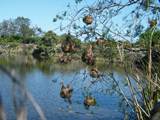Weaver news
| Hansell MH, Ruxton GD, Ennos AR 2014. Collected and self-secreted building materials and their contributions to compression and tension structures. Biological Journal of the Linnean Society online. Abstract. Animals that build structures have only two ways of obtaining their building materials: collecting them from the environment or secreting them. We identify a clear pattern among invertebrates: collected materials dominate in structures that bear loads predominantly in compression, whereas self-secreted materials dominate in structures that bear loads in tension. Among vertebrates, by contrast, structures in tension are much less common and may make use of either self-secreted or collected materials. Two possible explanations are examined for the difference between invertebrates and vertebrates. It may be that there has been evolutionary constraint on bodily secretions of vertebrates. Alternatively, the cost-effectiveness of self-secreted building materials diminishes with the load they bear in tension, and most vertebrates, because of their characteristically greater weight compared with invertebrates, exceed the viability threshold. Invertebrates have adapted biochemically varied secretions from a variety of glands to perform specialized mechanical roles. However, vertebrates have secretions with the potential to become building materials, in particular keratin, but only mucus-like secretions have evolved as building materials. The cost of suspended structures is predicted to become relatively greater with increased weight, whilst it will also become more difficult to find supports rigid enough to resist the forces they impose. This conforms to the relatively small size and small number of vertebrate structures in tension. The much larger, heavier suspended structures built by some social insects demonstrate that ecological factors may have important effects on the determination of weight thresholds. In this paper weavers are refered to much as examples of nests in tension (suspended from above). Much larger birds would not be able to build hanging nests that were attached to thin branches, providing some safety from predators, as much larger nests would need thicker branches as support, and these nests would then be accessible to more predators. Literature as featured in Weaver Watch news items |











